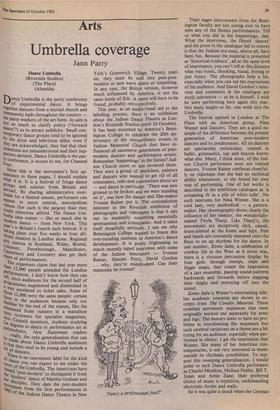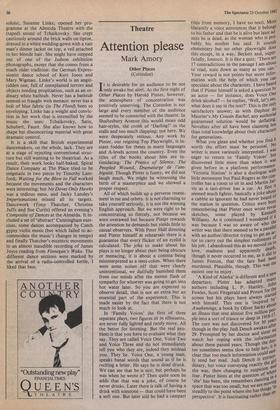Arts
Umbrella coverage
Jann Parry
Dance Umbrella (Riverside Studios) (The Place) (Almeida)
Dance Umbrella is the party conference of experimental dance. It brings together dancers from a myriad church and Community halls throughout the country the Party workers of the art form. Its aim is not so much to clarify policy (`forward dance'?) as to attract publicity. Small con- temporary dance groups tend to be ignored by the press and television alike; even if they are acknowledged, they feel that their intentions are misunderstood and their sup- Porters derided. Dance Umbrella is the par- ty conference, it occurs to me, for Channel Four.
Since this is the movement's first ap- pearance in these pages, I should explain what it is. It is a festival of fringe dance gr°11Ps and soloists from Britain and abroad. By sharing administrative over- heads for a limited season, performers can apPear in more central, metropolitan venues (for such is the jargon) than they could otherwise afford. The Dance Um- brella idea comes — like so much else in modern dance — from New York. This Year's is Britain's fourth such festival. It is tfaking place over five weeks in four dif- erent theatres in London alone. Regional arts centres in Scotland, Wales, Bristol, L.eicester, Peterborough, Manchester, Canterbury and Coventry also get their share
of performances.
t, he organism claim that last year more "an 12,000 people attended the London ,Performances. I don't know how they can tell, since audiences for the second half of Programmes augmented and diminished in a ,,_ way unrelated to ticket sales. Some of ',nose 12,000 were the same people: certain Isaees in the audiences became only too etanliliar by the end of the season, like the race front runners in a marathon r ce; reviewers for specialist magazines, iris Council monitors, students studying polytechnics, degrees in dance or performance art at P0lYtechnics, New Statesman readers be really, the only generalisation that can trade about Dance Umbrella audiences that they tend to be young and include a t of dancers. orThere is no convenient label for the kind co,,dance you can expect to see under the ejer of the Umbrella. The Americans have thill,ed 'post-modern' to distinguish it from Leer modern' dance of Martha Graham and her disciples. They date the post-modern ioky„ernent from the first performances in -u4 of the Judson Dance Theatre in New
York's Greenwich Village. Twenty years on, they must be well into post-post- modern or new wave dance or something. In any case, the British version, however much influenced by America, is not the same kettle of fish. A name will have to be found, probably retrospectively. This year, as an audio-visual aid to the labelling process, there is an exhibition about the Judson Dance Theatre at Lon- don's Riverside Studios (until 24 October). It has been mounted by America's Benn- ington College to celebrate the 20th an- niversary of the extraordinary events in Judson Memorial Church that have in- fluenced all successive generations of post- modern dancers and performance artists. Remember 'happenings' in the Sixties? Jud- son Church more or less invented them. They were a group of musicians, painters and dancers who wanted to get rid of all constraints, rules and conventions about art — and dance in particular. 'There was new ground to be broken and we were standing on it', was how the dancer and film-maker Yvonne Rainer put it. The contradiction inherent in the Riverside exhibition of photographs and videotapes is that it sets out to mummify something essentially spontaneous and iconoclastic. And it takes itself dreadfully seriously. I can see why Bennington College wanted to freeze this ever-receding moment in America's dance development. It is pretty frightening to watch recently taped interviews with some of the Judson innovators — Yvonne Rainer, Simone Forti, David Gordon
. why, they're middle-aged. Can their memories be trusted?
'Fancy a professional foul?'
Their eager interviewers from the Benn- ington faculty are too young ever to have seen any of the Sixties performances. Tell us what you did in the happenings, dad. What the interviews, the filmed 'dances' and the prose in the catalogue fail to convey is that the Judson era must, above all, have been fun. Because the material is presented as 'historical evidence', all at the same level of importance, you can't tell at this distance what was ironic, shocking, banal, boring or just funny. The photographs help a bit, especially when you can see the expressions of the audience. And David Gordon's inter- view and comments in the catalogue are wryly subversive — as he is himself. I wish he were performing here again this year. Not many laughs so far, one week into the Umbrella.
The festival opened in London at The Place with an American group, Nina Wiener and Dancers. They are a good ex- ample of the difference between the present generation of American post-modern dancers and its predecessors. All six dancers are spectacular technicians, trained in ballet, gymnastics, tap and heaven knows what else. Many, I think most, of the Jud- son Church performers were not trained dancers. Yvonne Rainer confesses cheerful- ly on videotape that she had no technical ability whatsoever, so she found her own way of performing. One of her works is described in the exhibition catalogue as 'a screaming fit in a pile of white tulle'. No such tantrums for Nina Wiener. She is a cool lady, very methodical — a pattern- maker. Her choreography shows clearly the influence of her mentor, the wonderfully- named Twyla Tharp. Like Tharp's, the movements are deceptively slick, casual, loose-jointed at the knees and hips. Feet and hands are constantly slammed onto the
floor to set up rhythms for the dance. In one number, Kemo Sabe, a celebration of
cowboy life in the West as it never was, there is a virtuoso percussion display by four girls: through stamps, claps and finger snaps, they create the impression of a jazz ensemble, passing sound-patterns backwards and forwards before slapping their thighs and moseying off into the sunset.
Kemo Sabe is Wiener's entertaining side: her academic concerns are shown in ex- cerpts from The Condor Material. These combine movement sequences that were originally worked out separately for arms and legs. The dancers seem to have no pro- blems in coordinating the sequences but
such cerebral variations on a theme are a bit trying for an audience, especially when per- formed in silence. I get the impression that Wiener, like many of her American con- temporaries, is not very interested in music outside its rhythmic possibilities. To sup- port this sweeping generalisation, I would point to such Dance Umbrella performers as Charles Moulton, Molissa Fenley, Bill T. Jones and Arnie Zane; their preferred choice of music is repetitive, undemanding electronic throbs and wails.
So it was quite a shock when the German
soloist, Susanne Linke, opened her pro- gramme at the Almeida Theatre with the (taped) sound of Tchaikovsky. She crept cautiously around the brick walls on tiptoe, dressed in a white wedding-gown with a vast man's dinner jacket on top, a veil attached to her blonde hair. She might have stepped out of one of the Judson exhibition photographs, except that she comes from a much older tradition: the German Expres- sionist dance school of Kurt Jooss and Mary Wigman. Linke's world is an angst- ridden one, full of unexplained terrors and objects needing propitiation, such as an or- dinary white bathtub. Never has a bathtub seemed so fraught with menace: never has a bolt of blue fabric (in The Flood) been so enveloping. Linke has a weight and convic- tion in her work that is intensified by the music she uses: Tchaikovsky, Satie, Schubert, Faure. She also knows how to shape her disconcerting material with great dramatic control.
It is a skill that British experimental dancemakers, on the whole, lack. They are at a stage of rejecting conventional struc- ture but still wanting to be theatrical. As a result, their work looks half-baked. Spiral Dance Company at The Place tried to be enigmatic in two pieces by Timothy Lam- ford; Waiting for the Blow to Fall worked because the movements and the characters were interesting; but No Doves Only Hawks was a tedious mess, and Jacky Lansley's Impersonations missed all its targets. Dancework (Tony Thatcher, Christine Juffs and Sue Curtis) offered an evening's Composite of Dances at the Almeida. It in- cluded a set of 'abstract' Cunningham exer- cises, some dances accompanied by Czech gypsy violin music (but which failed to ac- commodate the music's changes in tempo) and finally Thatcher's eccentric movements to an almost inaudible recording of James Joyce reading from Finnegan's Wake. The different dance sections were marked by the arrival of a radio-controlled kettle, I liked that best.











































 Previous page
Previous page